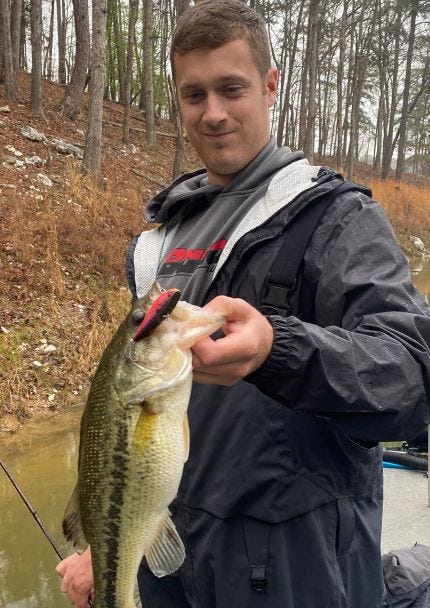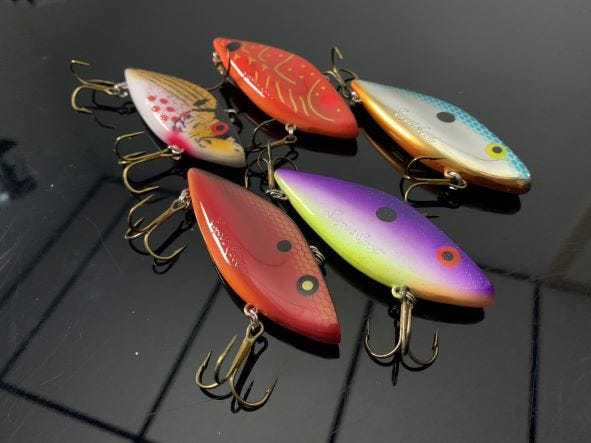- Dec 3, 2021
Choosing The Best Lipless Crankbait
All lipless crankbaits look quite similar, but each one carries attributes that work in different situations – or more importantly parts of the country. In this blog we will go over three key identifiers for choosing the right one based on forage, time of year, and fishing pressure!
Like I mentioned above, almost all lipless crankbaits look similar, but they certainly carry different attributes that fit different situations. Today I will be discussing my three favorite options, the Cotton Cordell Super Spot, BOOYAH Hard Knocker and BOOYAH One Knocker. Each one has some serious intricacies that we will look at and help you become more successful with them!
BOOYAH Hard Knocker - Sunset Craw


- Forage – What are the bass eating?
This might seem like a dumb question because everyone knows that bass in the wintertime are eating crawdads, duh? Well, while this is true the question that really arises is what type of crawdads? Are they green, brown, red, orange or maybe even blue? Figuring out the exact color of the prey is super important to selecting a good craw pattern – because the bass know! If I can’t find an actual crawdad scurrying around near the bank, I will simply base my decision on the color of the bottom and rocks because craws often mimic those colors. This will help you choose if a BOOYAH Hard Knocker in Rayburn Red is right or if maybe a subtle choice like Ghost Green Craw will work best. As always in almost every blog I like to slide in a quote from veteran angler Frank Scalish, “If color didn’t matter, why don’t we just paint everything black”. Wise words!
- Time of year – Spring, Fall, Winter, Summer?
This is a question most people solely base their entire selection on for a lipless bait, but they don’t take in all the factors for time of year! Most people say well, its wintertime lets pull out the red Super Spots and call it good, or its fall and let’s throw the Chrome Blue Hard Knockers. While this will work decently you need to really dive into what all is going on for each season and pick your lipless accordingly, this way you will get more bites! Each time of year places bass in different depth zones, feeding on different forage, and overall, in totally different moods but they will always appeal to the right lipless bait. Springtime is by far the easiest time to get bites and its pretty easy to narrow down your choices because bass are shallow and aggressive which brings to mind a BOOYAH Hard Knocker with its loud rattle system. Summer/Fall I lump into one category because the main forage is shad and bass are typically chasing bait near the surface. Times like this calls for a ½ oz. Cordell Spot in Chrome Blue or Chrome Black because you can launch it far and its shrill rattle resembles small baitfish scurrying quickly. Now, wintertime is when anglers often times prize their favorite lipless baits. Choosing an option here is best chosen with depth range and cover in mind. For anglers targeting deeper water like humps or flats I go for the ½ or ¾ oz. BOOYAH One Knocker because it has a heavy weight and a subtle rattle, but if I’m fishing shallow or above grass, I reach for the Cordell Spot because it has a lighter profile and seems to float above cover without getting snagged.
Cotton Cordell Super Spot


- Fishing pressure – How many boats do you see at the ramp?
I like to fish Lake Hamilton in central Arkansas a lot in the winter and spring, and it’s a relatively small lake around 7,500 acres. It has an enormous fishing pressure and how I know this is I can never find a spot to park my truck and boat trailer on a Saturday afternoon! When the pressure is high, choosing the right lipless becomes overtly important because bass might see 20 of the same exact red lipless Wizz past them on a single day. When the pressure is high my main tactic is to downsize my offering from a typical ½ oz. model to a smaller size like the ¼ oz. Hard Knocker or the ¼ oz. Super Spot. These smaller baits don’t put off near as much sound or vibration which really appeals to pressured bass. I have fished several tournaments as a co-angler and really cleaned up from the back of the boat by tossing one of these smaller options. Another welcome trick for high pressure is throwing altered colors. By this I mean taking a sharpie or some nail polish and coloring up one of your favorite models with some accents like flared gills, shad dots, or exaggerated lines. Little steps can often go a long way!
Don’t reach for the traditional lipless baits this wintertime, really do some thinking about it and grab the right one for the situation!
All the baits mentioned in todays blog can be found on Lurenet.com!



